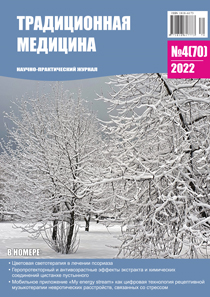Phytochemical analysis of biologically active substances of Euphorbia palustris herb
DOI:
https://doi.org/10.54296/18186173_2022_4_35Keywords:
Asclepias perennis, biologically active substances, flavonoids, organic acids, tannins, ascorbic acidAbstract
The aim of the study was to assess the quantitative content of biologically active substances (BAS) of Euphorbia palustris grass growing in the Astrakhan region.
Materials and methods. The object of the study was the herb Euphorbia palustris. The quantitative content of flavonoids in Euphorbia palustris herb was determined by spectrophotometry. The content of organic acids, tannins and ascorbic acid in the studied raw materials was studied by the titrimetric method. The experiments were repeated in 5 series. Statistical processing of the results was carried out according to standardized metrological characteristics.
Results. During the quantitative study of BAS of Euph?rbia pal?stris herb, it was found that the content of flavonoids is
2,4 %; organic acids – 1,2 %; tannins – 2,2 % and ascorbic acid – 3,2 %.
Conclusion. Thus, a quantitative analysis of the marsh milkweed grass growing on the territory of the Astrakhan region showed a high content of BAS, comparable to other plants of the genus Euphorbia and can be used for further research in order to create phytopreparations.
References
Euphorbia helioscopia L.: A phytochemical and pharmacological overview / Y. Yang [et al.] // Phytochemistry. 2021. Vol. 184. Р. 112649. DOI: 10.1016/j.phytochem.2020.112649.
Cayona, R. Phytochemicals of Euphorbia hirta L. and their inhibitory potential against SARS-CoV-2 Main Protease / R. Cayona, E. Creencia // Front Mol Biosci. 2022. no. 8. Р. 801401. DOI: 10.3389/fmolb.2021.801401.
Optimization of extraction conditions of phytochemical compounds and anti-gout activity of Euphorbia hirta L. (Ara Tanah) Using Response surface methodology and liquid chromatography-mass spectrometry (LC-MS) analysis / F.I. Abu Bakar [et al.] // Evid Based Complement Alternat Med. – 2020. – Vol. 2020. – Р.4501261. DOI: 10.1155/2020/4501261.
Phytochemical analyses and antibacterial activities of Erodium, Euphorbia, Logoecia and Tamarix species / K.J. Al-Hadid [et al.] // J Infect Dev Ctries. 2019. Vol. 13, no. 11. Р. 1013-1020. DOI: 10.3855/jidc.11776.
Anti-Cancer Activities of Diterpenoids Derived from Euphorbia fischeriana / J.B. Steud [et al.] // Molecules. 2018. Vol. 23, no. 2. Р. 387. DOI: 10.3390/molecules23020387.
Euphorbia characias: Phytochemistry and biological activities / A. Fais [et al.] // Plants (Basel). 2021. Vol. 10, no. 7. Р. 1468. DOI: 10.3390/plants10071468.
Study on chemical constituents from Euphorbia thymifolia / L. Jin-Long [et al.] // Zhongguo Zhong Yao Za Zhi. 2020. Vol. 45, no. 21. P. 5226-5231. DOI: 10.19540/j.cnki.cjcmm.20200703.201.
Phytotoxic ent-Isopimarane-Type Diterpenoids from Euphorbia hylonoma / W.J. Wei [et al.] // J Nat Prod. 2018. Vol. 81, no. 11. Р. 2381-2391. DOI: 10.1021/acs.jnatprod.8b00365.
Pharmacological and nutritive potential of Euphorbia granulate / S. Ahmad [et al.] // J Complement Integr Med. 2018. Vol. 16, no. 2. DOI: 10.1515/jcim-2018-0149.
Chemical constituents of triterpenoids from Euphorbia resinifera / Y.J. Li [et al.] // Zhongguo Zhong Yao Za Zhi. 2021. Vol. 46, no. 17. Р. 4433-4437. DOI: 10.19540/j.cnki.cjcmm.20210621.201.
Салтыкова, Л.Д. Количественное определение аскорбиновой кислоты в растительном сырье молочая прутьевидного / Л.Д. Салтыкова, Н.И. Гильфанова, Е.В. Щепетова // Материалы научных трудов XII Международной научно-практической конференции «Фундаментальные и прикладные проблемы получения новых материалов: исследования, инновации и технологии». – Астрахань, 24–27 апреля 2018. – С.44–46.
Березуцкий, М.А. Экспериментальные исследования биологической активности компонентов природного активатора теломеразы – молочая приземистого (обзор литературы) / М.А. Березуцкий, Ю.В. Белоногова, Е.Э. Комарова, О.В. Синичкина // Дневник науки. – 2019. – № 6(30). – С.5.
Кривошеева, Е.М. Фармакодинамические аспекты афродиатической активности Euphorbia fis с heriana stend. (молочая Фишера) в эксперименте / Е.М. Кривошеева, Е.В. Фефелова, Л.Н. Шантанова // Загальна патологія та патологічна фізіологія. – 2011. – Т. 6, № 4. – С. 75-79.
Кривошеева, Е.М. Спектр фармакологической активности растительных адаптогенов / Е.М. Кривошеева, Е.В. Фефелова, С.Т. Кохан // Фундаментальные исследования. – 2011. – № 6. – С.85–88.
Вазорелаксантное действие полифенольных соединений растений Euphorbia в зависимости от их химической структуры / Ф.Ю. Ахмедов, А.Э. Зайнобиддинов, У.Г. Гайибов [и др.] // Universum: химия и биология. – 2020. – № 10-1(76). – С.14–19.
Находка лекарственного вида - молочая пятнистого (Euphorbia maculata L.) на территории Саратовской области / М.А. Березуцкий, Н.А. Дурнова, Ю.В. Белоногова, В.В. Мишкина // Modern Science. – 2021. – № 11–1. – С.14–17.
Соловьев, С.В. Европейский вид Euphorbia lucida Waldst. et Kit. в изолированном фрагменте ареала в Тюменской области / С.В. Соловьев, И.В. Кузьмин // Фиторазнообразие Восточной Европы. – 2014. – Т. 8, № 2. – С.67–75.
Государственная фармакопея Российской Федерации. – Издание XIV. Том II. – М.: Министерство здравоохранения РФ, 2018. [Электронный ресурс]. Режим доступа: https://femb.ru/record/pharmacopea14, свободный.
Downloads
Published
How to Cite
Issue
Section
License
Reproduction of any materials without the written permission of the publisher is prohibited.
The responsibility for the accuracy of the information contained in articles and advertisements are the authors and advertisers.






